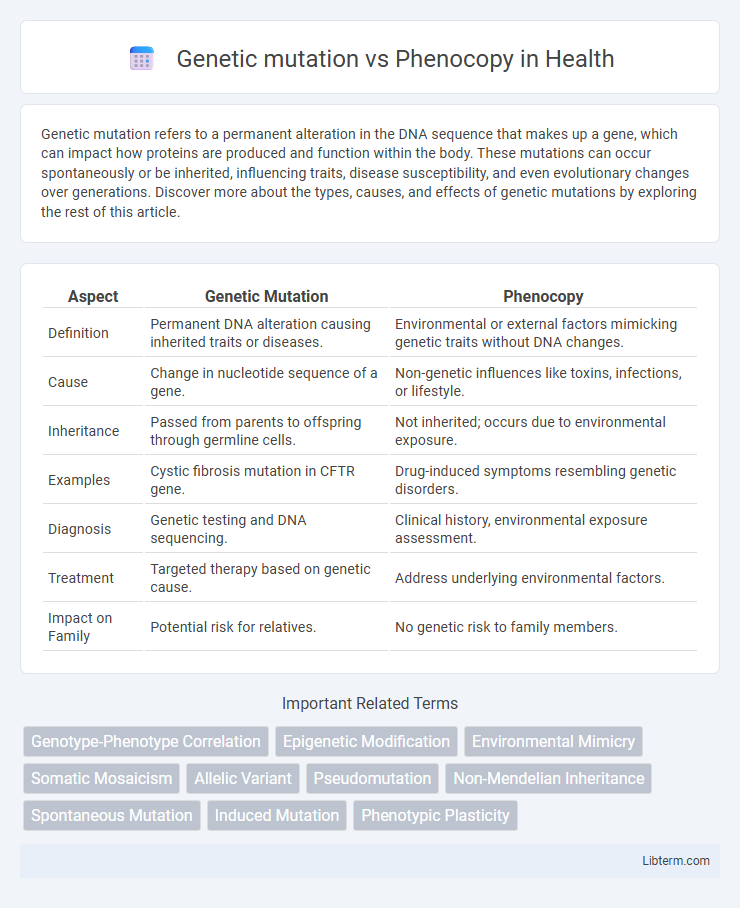Genetic mutation refers to a permanent alteration in the DNA sequence that makes up a gene, which can impact how proteins are produced and function within the body. These mutations can occur spontaneously or be inherited, influencing traits, disease susceptibility, and even evolutionary changes over generations. Discover more about the types, causes, and effects of genetic mutations by exploring the rest of this article.
Table of Comparison
| Aspect | Genetic Mutation | Phenocopy |
|---|---|---|
| Definition | Permanent DNA alteration causing inherited traits or diseases. | Environmental or external factors mimicking genetic traits without DNA changes. |
| Cause | Change in nucleotide sequence of a gene. | Non-genetic influences like toxins, infections, or lifestyle. |
| Inheritance | Passed from parents to offspring through germline cells. | Not inherited; occurs due to environmental exposure. |
| Examples | Cystic fibrosis mutation in CFTR gene. | Drug-induced symptoms resembling genetic disorders. |
| Diagnosis | Genetic testing and DNA sequencing. | Clinical history, environmental exposure assessment. |
| Treatment | Targeted therapy based on genetic cause. | Address underlying environmental factors. |
| Impact on Family | Potential risk for relatives. | No genetic risk to family members. |
Understanding Genetic Mutation: Definition and Types
Genetic mutation refers to permanent alterations in the DNA sequence that can affect gene function and lead to inherited traits or diseases, categorized into types such as point mutations, insertions, deletions, and chromosomal rearrangements. Phenocopy, in contrast, describes an environmentally induced trait that mimics a genetic mutation's phenotype without changes to the DNA sequence. Understanding these distinctions is crucial for accurate diagnosis and research in genetics and molecular biology.
Phenocopy Explained: Causes and Characteristics
Phenocopy refers to an environmental or non-genetic factor that produces a phenotype identical to that caused by a genetic mutation, though no alteration occurs in the individual's DNA sequence. Common causes of phenocopies include exposure to chemicals, infections, nutritional deficiencies, or physical factors during critical developmental periods. Unlike genetic mutations which are inherited, phenocopies do not follow Mendelian inheritance patterns but mimic genetic disorders by producing similar anatomical or physiological traits.
Key Differences Between Genetic Mutation and Phenocopy
Genetic mutations involve permanent alterations in the DNA sequence that can be inherited or occur spontaneously, leading to changes in an organism's traits. Phenocopies mimic genetic disorders but result from environmental factors, not changes in the genetic code, and are typically non-heritable. Key differences include the origin of the trait--genetic mutations arise from DNA sequence changes, whereas phenocopies stem from external influences causing similar phenotypic effects.
Mechanisms of Genetic Mutation in Organisms
Genetic mutations arise from changes in the DNA sequence due to errors during DNA replication, exposure to mutagens, or chromosomal rearrangements, leading to permanent alterations in the organism's genetic code. These mutations can be point mutations, insertions, deletions, or frameshifts that affect gene function and inheritance patterns. Unlike phenocopies, which are environmentally induced phenotypic changes mimicking genetic traits, genetic mutations directly alter the genotype and can be passed to subsequent generations.
Environmental Factors Leading to Phenocopy
Environmental factors such as exposure to toxins, nutritional deficiencies, and infections can induce phenocopies by mimicking genetic mutations' physical traits without altering the DNA sequence. These external influences disrupt normal developmental processes, resulting in phenotypes identical to those caused by specific genetic mutations. Understanding phenocopies is crucial for distinguishing between inherited genetic disorders and environmentally induced phenotypic variations.
Clinical Implications: Diagnosing Genetic Mutations vs. Phenocopies
Accurate diagnosis of genetic mutations versus phenocopies is critical for effective clinical management and genetic counseling, as mutations often require targeted therapies and family risk assessment. Genetic testing, including whole-exome sequencing and gene panels, helps confirm pathogenic variants, whereas phenocopies typically arise from environmental factors or non-genetic causes, necessitating alternative diagnostic approaches. Misdiagnosis can lead to inappropriate treatment plans and misinformed prognosis, highlighting the importance of integrating molecular diagnostics with detailed phenotypic evaluation in clinical practice.
Case Studies: Real-world Examples of Mutation and Phenocopy
Case studies reveal distinct differences between genetic mutations and phenocopies through real-world examples such as sickle cell anemia caused by a point mutation in the HBB gene and phenocopies like thalassemia traits mimicking sickle cell disease due to environmental factors. Research on inherited cancer syndromes, like BRCA1 mutations leading to hereditary breast cancer, contrasts with phenocopies resulting from lifestyle-induced breast cancer cases showing similar phenotypes without genetic mutations. These case studies emphasize the importance of genetic testing and environmental assessment in accurately diagnosing and managing diseases that present with overlapping clinical features.
Methods for Differentiating Mutation from Phenocopy
Genetic mutations are identified through DNA sequencing techniques such as whole-exome sequencing or targeted gene panels, which detect specific nucleotide changes, whereas phenocopies lack these alterations and arise from environmental factors or epigenetic modifications. Functional assays, including protein expression analysis and enzyme activity tests, help differentiate mutations causing altered gene products from phenocopies with normal genetic sequences but phenotypic alterations. Family history analysis and segregation studies further clarify inheritance patterns, with mutations typically showing Mendelian inheritance and phenocopies not following predictable genetic transmission.
Impact on Heredity and Inheritance Patterns
Genetic mutations directly alter DNA sequences, leading to heritable changes that follow Mendelian inheritance patterns or more complex genetic models depending on the mutation type and gene involved. Phenocopies, however, mimic genetic disorders through environmental influences without altering the DNA and do not pass through generations genetically, thus lacking true heritability. Understanding these distinctions is crucial for accurate genetic counseling and predicting inheritance risks in families.
Future Directions in Research: Mutation and Phenocopy
Future research on genetic mutations and phenocopies emphasizes advanced genomic sequencing technologies and machine learning algorithms to distinguish between hereditary mutations and environmentally induced phenocopies. Investigating epigenetic modifications and gene-environment interactions offers promising insights into phenotypic variability and disease presentation. Development of precision medicine approaches targets the specific molecular mechanisms underlying mutations and phenocopies to improve diagnosis and personalized treatment strategies.
Genetic mutation Infographic

 libterm.com
libterm.com